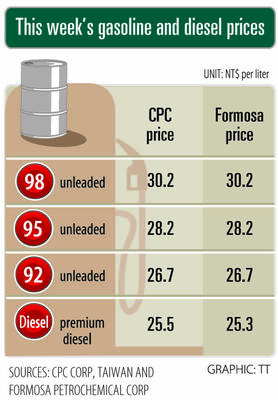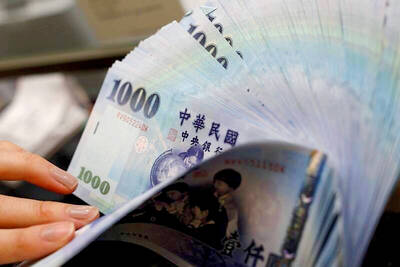Sony Corp shares yesterday fell the most in almost two years after the electronics maker missed profit estimates and forecast weaker sales and operating profits across most of its business units.
The stock fell 6.1 percent to ¥5,073 in Tokyo, the biggest one-day drop since June 2016 and the first trading session after last week’s earnings.
The move wiped out about US$4 billion from the company’s market value, while volume doubled the 180-day average.
Sales in Sony’s mobile, PlayStation, music, movies and home entertainment divisions are forecast to decline in the year to March next year, the Tokyo-based company said in a statement on Friday last week.
Only cameras, chips and financial services were seen improving slightly.
According to the outlook, operating profit is to decline to ¥670 billion (US$6.1 billion), less than analysts’ prediction for ¥747 billion.
Analysts expressed concerned over Sony’s weak outlook for smartphone camera chips, where it forecast a 39 percent decline in operating profit.
JPMorgan Chase & Co analyst J.J. Park lowered the firm’s price target for Sony from ¥5,400 to ¥5,200, telling investors to stay on the sidelines until shares finish adjusting to the weaker demand for smartphones.
“We expect Sony’s share price to follow the performance in Apple [Inc] supply chain names, which have shown a meaningful correction,” Park, Ky Oh and Hisashi Moriyama wrote in a note to clients on Saturday, in which they maintained their neutral rating on the stock. “We recommend that investors find a better entry point after a share price correction.”
Yesterday’s decline brought the gap between analyst price targets and the actual price to the widest since March 2016, data compiled by Bloomberg showed.
Sony CEO Kenichiro Yoshida needs to boost revenue by coming up with new products and services after five years of restructuring that he pushed through as chief financial officer with his predecessor, Kazuo Hirai.
While the changes have left Sony on solid footing, the company remains vulnerable to any potential downturn given that it is the top supplier for image sensors that go into the devices, including Apple’s iPhone.
Total operating profit was a record ¥735 billion for the year through March. Analysts were projecting an average of ¥743 billion.
Full-year sales rose 12 percent to ¥8.54 trillion.
“We’ve delivered on the promises we laid out and reached ¥500 billion profits in back-to-back years,” Sony chief financial officer Hiroki Totoki said at a news conference after the results. “Given we’ve never before achieved that, that accomplishment weighs very heavily on our shoulders, but that’s why it’s very important to continue to properly earn stable profits.”
SMARTPHONE WOES
Cooling demand for smartphones across markets is hitting Sony on two fronts: less demand for mobile camera chips and poor demand for Sony’s own models.
The Xperia division recorded a write-down and forecast an operating loss of ¥15 billion in the coming year.
The semiconductor unit would post a 39 percent decline in operating profit, Sony said, even though sales are seen climbing slightly.
“It’s not a great time for smartphones,” Asymmetric Advisors senior strategist Amir Anvarzadeh said in Singapore. “Sony has had phenomenal growth in the past few years, so it doesn’t take a genius to see that it will be harder to maintain from here on.”
Still, many investors remain optimistic, with Sony shares near 10-year highs.
A Bloomberg analysis of share price data suggested that chief financial officers turned CEOs tend to perform well.
In the 28 instances since the mid-1990s when large nonfinancial corporations promoted their finance chiefs to the top job, the stocks on average did twice as well as the broader market.
Sony shares were up about 6 percent before the results, following a 55 percent rally last year.
“Yoshida-san understands the stock market very well,” Bloomberg Intelligence analyst Masahiro Wakasugi said. “Expectations are as high as ever, but he’s the type who can probably respond to what the market wants.”
Operating profit at the chip unit was ¥164 billion in the latest fiscal year, better than Sony’s own estimate for ¥155 billion.
For the coming year, the company forecast a decline to ¥100 billion.
Sony said it was stepping up capital expenditure in the unit to ¥160 billion, of which ¥130 billion would be for image sensors.
Apple suppliers, including Sony, have been hit by poor demand for the iPhone X. However, with some Chinese smartphone manufacturers, such as Huawei Technologies Co (華為), now outfitting models with three rear-facing cameras, demand for image sensors might hold up.
Full-year operating profit in the gaming division was ¥177.5 billion, missing Sony’s estimate for ¥180 billion. The company sold 19 million PlayStation 4s, matching its forecast.
In the coming year, it expects to generate ¥190 billion in operating profit, while PlayStation 4 sales would slow to 16 million.
The film unit had an operating profit of ¥41.1 billion on sales of ¥1.01 trillion, compared with Sony’s estimate for ¥39 billion and ¥1.02 trillion respectively.
The company sees operating profit remaining mostly flat at ¥42 billion, with revenue shrinking to ¥960 billion.
Sony had one of its strongest box office performances in years, announcing this month that the new Jumanji movie had become its highest-grossing film in history.

Merida Industry Co (美利達) has seen signs of recovery in the US and European markets this year, as customers are gradually depleting their inventories, the bicycle maker told shareholders yesterday. Given robust growth in new orders at its Taiwanese factory, coupled with its subsidiaries’ improving performance, Merida said it remains confident about the bicycle market’s prospects and expects steady growth in its core business this year. CAUTION ON CHINA However, the company must handle the Chinese market with great caution, as sales of road bikes there have declined significantly, affecting its revenue and profitability, Merida said in a statement, adding that it would

i Gasoline and diesel prices at fuel stations are this week to rise NT$0.1 per liter, as tensions in the Middle East pushed crude oil prices higher last week, CPC Corp, Taiwan (台灣中油) and Formosa Petrochemical Corp (台塑石化) said yesterday. International crude oil prices last week rose for the third consecutive week due to an escalating conflict between Israel and Iran, as the market is concerned that the situation in the Middle East might affect crude oil supply, CPC and Formosa said in separate statements. Front-month Brent crude oil futures — the international oil benchmark — rose 3.75 percent to settle at US$77.01

RISING: Strong exports, and life insurance companies’ efforts to manage currency risks indicates the NT dollar would eventually pass the 29 level, an expert said The New Taiwan dollar yesterday rallied to its strongest in three years amid inflows to the nation’s stock market and broad-based weakness in the US dollar. Exporter sales of the US currency and a repatriation of funds from local asset managers also played a role, said two traders, who asked not to be identified as they were not authorized to speak publicly. State-owned banks were seen buying the greenback yesterday, but only at a moderate scale, the traders said. The local currency gained 0.77 percent, outperforming almost all of its Asian peers, to close at NT$29.165 per US dollar in Taipei trading yesterday. The

RECORD LOW: Global firms’ increased inventories, tariff disputes not yet impacting Taiwan and new graduates not yet entering the market contributed to the decrease Taiwan’s unemployment rate last month dropped to 3.3 percent, the lowest for the month in 25 years, as strong exports and resilient domestic demand boosted hiring across various sectors, the Directorate-General of Budget, Accounting and Statistics (DGBAS) said yesterday. After seasonal adjustments, the jobless rate eased to 3.34 percent, the best performance in 24 years, suggesting a stable labor market, although a mild increase is expected with the graduation season from this month through August, the statistics agency said. “Potential shocks from tariff disputes between the US and China have yet to affect Taiwan’s job market,” Census Department Deputy Director Tan Wen-ling